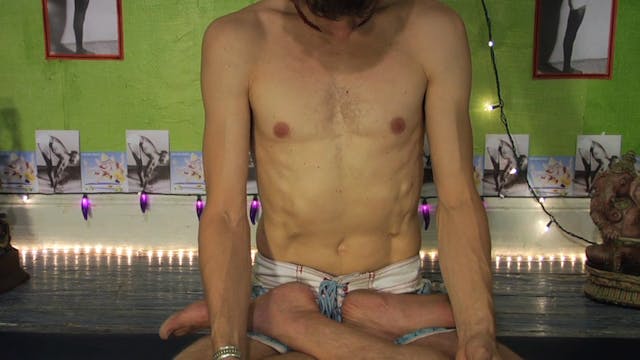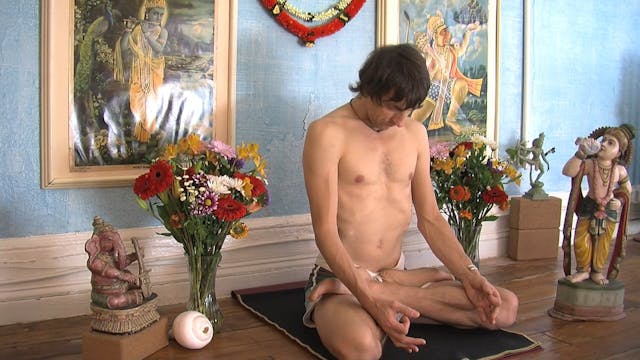Guide to Ujjayi Breathing & Ashtanga Pranayama Seq
3 hrs
21 videos (6-30 min each)
100% Practice
Part 1: A Guide to Ujjayi Breathing
The first 9 videos are a set of breathing practices that will help you better understand how to breath in your asana practice, give you a strong foundation for learning pranayama and form the beginning steps to working with the Sri K Pattabhi Jois’s Ashtanga Pranayama sequence.
Part 2: A Guide to the Ashtanga Pranayama Sequence
The first 6 videos in part 2 introduce you to the Ashtanga Pranayama sequence by giving you step by step, detailed instruction in each of the five pranayama’s that make up the sequence. You can study each pranayama separately or all at the same time with the Full Instructed Pranayama Sequence.
The last 6 videos in part 2 is where you can practice each pranayama separately without instruction or you can practice the entire thirty plus minute Ashtanga Pranayama Sequence without instruction.
"In presenting this material I aim to transform your ideas about the role that your breath can play in your daily practice, to see how the consciousness that you develop through breath awareness leads you into the greater spiritual context of your life. I aim to set your imagination ablaze on the vital subject of breathing as your principal source of Self knowledge." - David Garrigues
-
Viloma Inhalation Exercise with Instruction
In this exercise you will interrupt your inhalation in 3 stages. David will instruct you through the entire exercise so you can learn to extend your inhalation and get the feeling for stopping the breath in short intervals. This exercise will also teach you jalandhara bandha.
-
Viloma Inhalation Exercise (no extra instruction)
In this exercise you will interrupt your inhalation in 3 stages. There is no extra instruction and so you are allowed to explore the gap in between the breaths on your own. By learning to breath in more thoroughly jalandhara bandha will become more natural and you will discover the power of this...
-
Viloma Exhalation Exercise with Instruction
In this exercise you will interrupt your exhalation in 3 stages. It will help teach you mula bandha and uddiyana bandha. David will instruct you through the entire exercise so you can learn to extend your exhalation and get the feeling for stopping the breath in short intervals.
-
Viloma Exhalation Exercise (no extra instruction)
In this exercise you will interrupt your exhalation in 3 stages. There is no extra instruction and so you are allowed to explore the gap in between the breaths on your own. By breathing out 3 times without breathing in you will learn to exhale more thoroughly.
-
Viloma Khumbaka Exercise on Exhalation
This exercise introduces kumbhaka into your breathing practice. Kumbhaka is retention or suspension of the breath. It is the phase between inhalation and exhalation. Kumbhaka is the confining of the prana inside.
"Respiration being disturbed, the mind becomes disturbed. By restraining respi...
-
Viloma Kumbaka Exercise on Inhalation
This exercise introduces kumbhaka into your breathing practice. Kumbhaka is retention or suspension of the breath. It is the phase between inhalation and exhalation. Kumbhaka is the confining of the prana inside.
The practice of kumbhaka is less about breath control and more about mind contro... -
Instructed Ashtanga Yoga Pranayama Sequence
I suggest you learn the ashtanga pranayama sequence by slowly working your way through the sequence in small increments, the same way that you learn the ashtanga asana sequences. At first your practice will be short, only two to four minutes long, but you can extend the time by repeating what you...
-
Instructed First Pranayama (Parts A and B)
-
instructed Second Pranayama (Parts A and B)
Nadi Shodhana (cleansing of pranic channels). Developing skill in the technique of nadi shodana is necessary in order to udnerstand the unique language and purpose of pranayama. The second pranayama introduces digital pranayama also known as alternate nostril breathing.
In this video David g...
-
instructed Third Pranayama Bhastrika
Bhastrika: Bellows
Bhastrika is a highly active, energy rousing technique that tones the absomen and helps you to activate your respiratory musuclature. The forceful rhythmic pumping of the breath churns the belly and stirs up the dormant, sluggish energy within muladhara, the root support cha...
-
instructed Fourth Pranayama Surya and Chandra Bhedana
Surya: Sun, solar, heating, right nostril
Chandra: moon, lunar, cooling, left nostril
Bhedana: clear, cleanse, free flowingPerform this kumbhaka in order to clear the two principal nadis, ida and pingala, also known as the sun and moon, and also to cleanse the overall system of nadis throug...
-
instructed Fifth Pranayama Sitali
Sitali: cooling
Sitali is performed on the inhalation by opening the mouth, forming the lips into an "O," extending the tongue out of the mouth, and curling the ends into a funnel shape. Then draw the breath in across the tongue with a sucking noise and perform kumbhaka after completing the i...
-
Led Pranayama Sequence Ujjayi (Parts A and B)
Uj: upward, expansive
Jaya: victorious
Bahya: external
Antara: internal
Kumbhaka: retentionIt is natural and logical to retain the breath for a longer duration after inhalation than after exhalation. And this indicates that achieving the proper ration sorts itself out if you follow the gu...
-
Led Pranayama Sequence Nadi Shodana (Parts A and B)
Working with the technique of nadi shodana gives the discerning yogi an elementary means of regulating his prana. By manipulating the flow of breath through ida and pingala, he learns to direct prana's movements into shushumna. The repeated practice of nadi shodana and the other pranayama techniq...
-
Led Pranayama Sequence Bhastrika
To practice this pranayama technique you imitate the rhythmic pumping action of a blacksmith's bellows by rapidly contracting and releasing your abdomen and performing a long series of staccato, forced exhalations followed by immediate, reflexive inhalations.
Bhastrika is also one of the six ...
-
Led Pranayama Sequence Surya and Chandra Bhedana
Surya: Sun, solar, heating, right nostril
Chandra: moon, lunar, cooling, left nostril
Bhedana: clear, cleanse, free flowingThe solar right side is said to be like the sun: fiery, generating heat and light, active, and masculine. The lunar left side is said to be like the moon: cooling, rece...
-
Led Pranayama Sequence Sitali
Both techniques, ujjayi and sitali, involve narrowing the glottis. This action enables you to stretch, lengthen, and regulate your breath. With sitali you can experience the inhalation as a pull; draw the breath in with a suction like action, a sipping in of nectar.
From the Shiva Samhita
"When... -
Led Ashtanga Pranayama Sequence
I suggest you learn the ashtanga pranayama sequence by slowly working your way through the sequence in small increments, the same way that you learn the ashtanga asana sequences. At first your practice will be short, only two to four minutes long, but you can extend the time by repeating what you...
-
Are you breathing too loud or too soft in your asana practice?
Students often ask me, "Am I breathing too loud, heavy?" or "Am I breathing too soft, quiet?" My answer is that the breathing should be natural. Sri K Pattabhis Jois said the breath should be medium or free.
When you are confused or frustrated about your breath it is best to align the sound ... -
Patterns of Apana and Prana Basics 101
Apana vayu governs the lower abdominal and pelvic region within the torso from the navel to the pelvic floor. By tuning into the pattern of apana vayu, the investigative yogi gains full knowledge of the intricacies of exhaling, including utilizing the full extent of subtle breathing muscles withi...
-
Jalandha Bandha Basics 101
Jalandhara: net, support,
Bandha: lock, close, shut, re direct
Chin Lock (net-holding lock. Like a fisherman would use to hold one end of his net beneath his chin, while casting out the rest of it).
Jalandhara bandha, the chin lock, is an essential ashtanga yoga technique, it is the up... -
Are there other seated positions I can do for my pranayama practice besides Lotus?
When setting up to sit for pranayama, nearly any upright position can be used. The material in the "Imagery for the Central Axis" section in my book provides a universal set of instructions that can be used for setting up any seated position in for pranayama.
Remember to choose your pranayama ...
-
How do I do the vishnu mudra hand position
Vishnu-sustainer god, pervader god,
Mudra, seal, gestureVishnu Mudra is the hand position used for the second (Nadi Shodhana) and fourth (Surya and Chandra Bhedana) pranayama in the Ashtanga Pranayama sequence.
To perform vishnu mudra bring the right hand up in front of your face, pal...
-
Build Pranayama Padmasana Directly Over Pelvic Floor
Be sure to adopt a position that enables you to sit tall with the head, torso, and hips in a true vertical line so that you can illuminate shushumna nadi through your study of breathing. The vertical axis can be thought of a spanning from the crown of the head down to the center of the pelvic flo...
-
Why is Kumbhaka important in pranayama
The main reason why pranayama is one limb of only eight limbs in ashtanga yoga is because of the role that kumbhaka (breath retention) plays in concentrating awareness and contemplating the mind. Retaining the breath is a principle means of restraining thought, of brininging about the ultimate go...



























